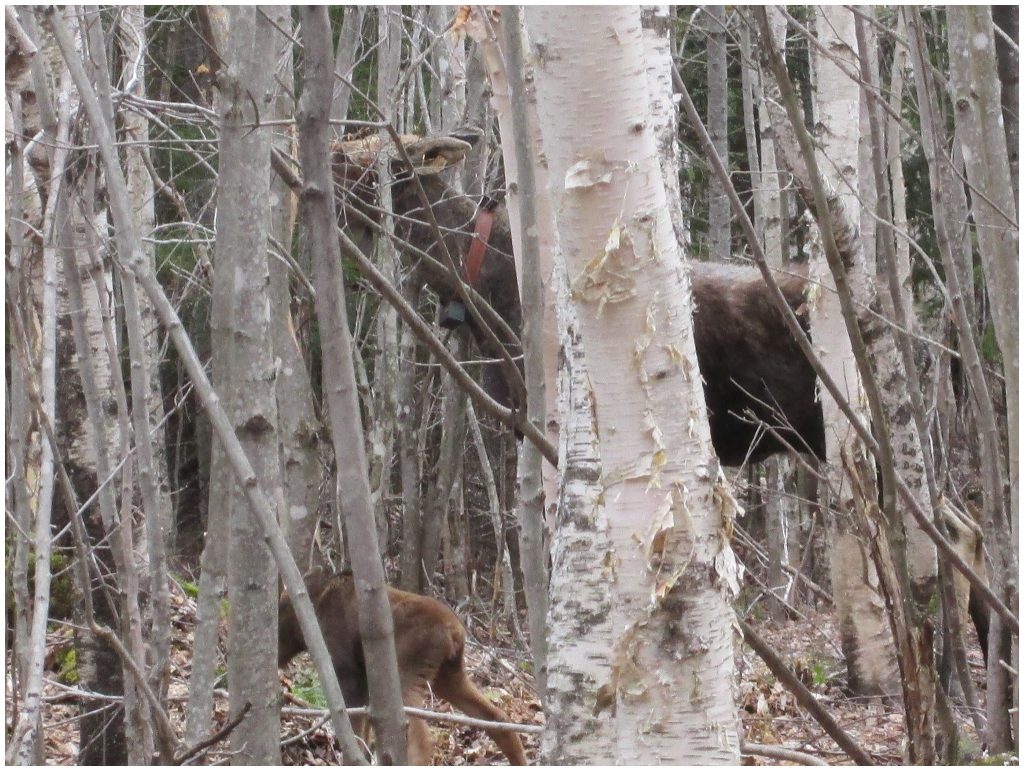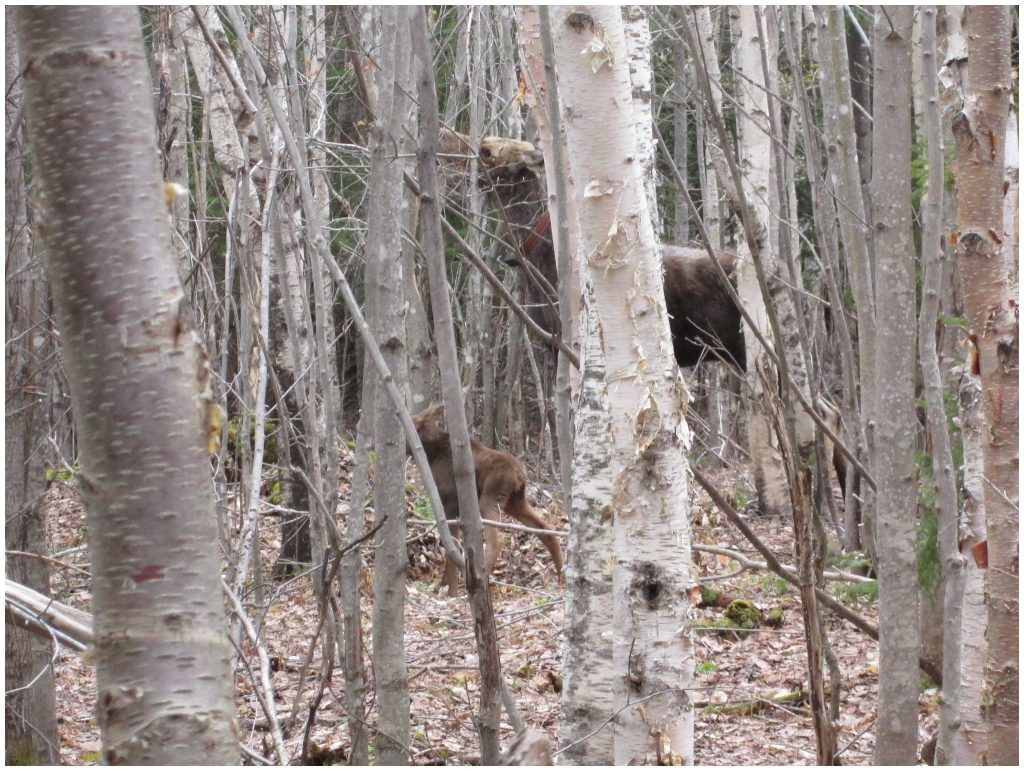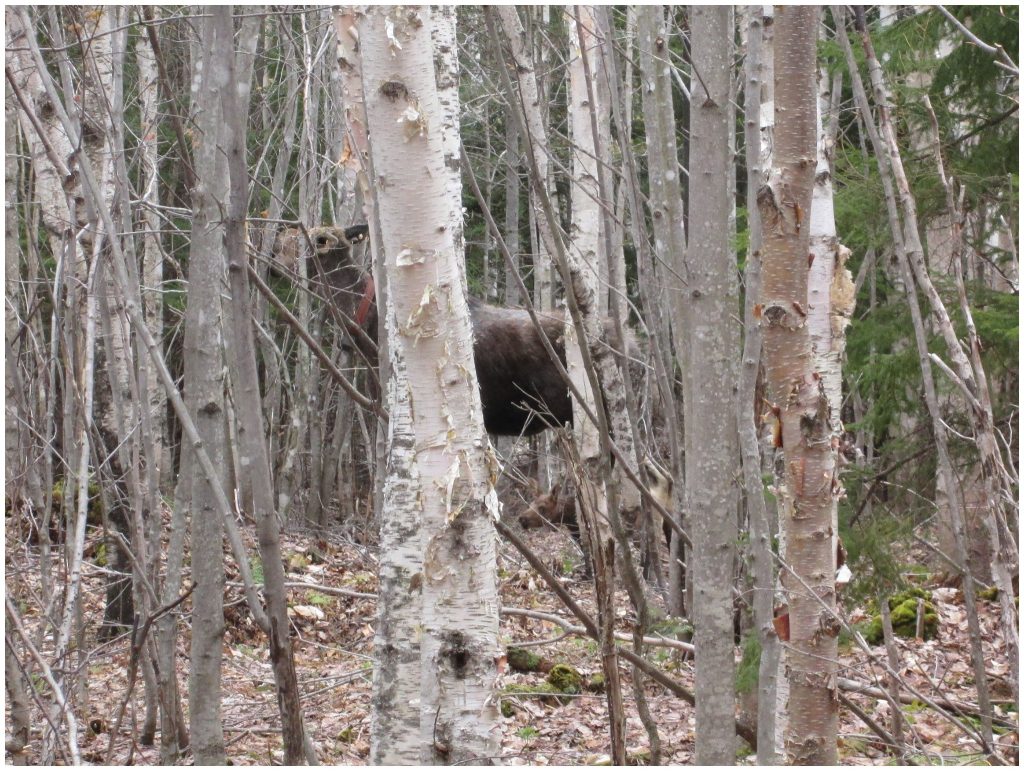May 18, 2016 at 10:08 am
By Scott McLellan, IFW Wildlife Biologist
 As part of the moose survival study that the Maine Department of Inland Fisheries and Wildlife (MDIFW) initiated in 2014, it is important to understand the productivity of the population to guide management decisions. In late April, wildlife biologists begin to closely examine the daily locations of each adult cow to determine whether or not they have localized into one small area. A cow that localizes into a small area at this point of the spring usually means that she has given birth to a calf or calves. Once this determination has been made, biologists use tracking (or telemetry) equipment to visit this site when she is present to obtain a visual on her, and hopefully a calf or two at her side.
Information that is collected on site includes, but is not limited to: the age of the calf/calves, behavior of each animal, habitat characteristics, topographical features, weather, date, and time. Photos are also taken if the opportunity presents itself. Once all of the information is collected, the site is exited quietly and this process is repeated on a weekly basis until the end of July. At the conclusion of this field season, biologists analyze all of the data to determine the rate of reproduction among adult cows, the twinning rate, and the mortality rate of calves during the first 3 months of their lives. These data are eventually plugged into a complex management system that enables biologists to more clearly view a picture of the moose population.
As part of the moose survival study that the Maine Department of Inland Fisheries and Wildlife (MDIFW) initiated in 2014, it is important to understand the productivity of the population to guide management decisions. In late April, wildlife biologists begin to closely examine the daily locations of each adult cow to determine whether or not they have localized into one small area. A cow that localizes into a small area at this point of the spring usually means that she has given birth to a calf or calves. Once this determination has been made, biologists use tracking (or telemetry) equipment to visit this site when she is present to obtain a visual on her, and hopefully a calf or two at her side.
Information that is collected on site includes, but is not limited to: the age of the calf/calves, behavior of each animal, habitat characteristics, topographical features, weather, date, and time. Photos are also taken if the opportunity presents itself. Once all of the information is collected, the site is exited quietly and this process is repeated on a weekly basis until the end of July. At the conclusion of this field season, biologists analyze all of the data to determine the rate of reproduction among adult cows, the twinning rate, and the mortality rate of calves during the first 3 months of their lives. These data are eventually plugged into a complex management system that enables biologists to more clearly view a picture of the moose population.


 As part of the moose survival study that the Maine Department of Inland Fisheries and Wildlife (MDIFW) initiated in 2014, it is important to understand the productivity of the population to guide management decisions. In late April, wildlife biologists begin to closely examine the daily locations of each adult cow to determine whether or not they have localized into one small area. A cow that localizes into a small area at this point of the spring usually means that she has given birth to a calf or calves. Once this determination has been made, biologists use tracking (or telemetry) equipment to visit this site when she is present to obtain a visual on her, and hopefully a calf or two at her side.
Information that is collected on site includes, but is not limited to: the age of the calf/calves, behavior of each animal, habitat characteristics, topographical features, weather, date, and time. Photos are also taken if the opportunity presents itself. Once all of the information is collected, the site is exited quietly and this process is repeated on a weekly basis until the end of July. At the conclusion of this field season, biologists analyze all of the data to determine the rate of reproduction among adult cows, the twinning rate, and the mortality rate of calves during the first 3 months of their lives. These data are eventually plugged into a complex management system that enables biologists to more clearly view a picture of the moose population.
As part of the moose survival study that the Maine Department of Inland Fisheries and Wildlife (MDIFW) initiated in 2014, it is important to understand the productivity of the population to guide management decisions. In late April, wildlife biologists begin to closely examine the daily locations of each adult cow to determine whether or not they have localized into one small area. A cow that localizes into a small area at this point of the spring usually means that she has given birth to a calf or calves. Once this determination has been made, biologists use tracking (or telemetry) equipment to visit this site when she is present to obtain a visual on her, and hopefully a calf or two at her side.
Information that is collected on site includes, but is not limited to: the age of the calf/calves, behavior of each animal, habitat characteristics, topographical features, weather, date, and time. Photos are also taken if the opportunity presents itself. Once all of the information is collected, the site is exited quietly and this process is repeated on a weekly basis until the end of July. At the conclusion of this field season, biologists analyze all of the data to determine the rate of reproduction among adult cows, the twinning rate, and the mortality rate of calves during the first 3 months of their lives. These data are eventually plugged into a complex management system that enables biologists to more clearly view a picture of the moose population.


Categories